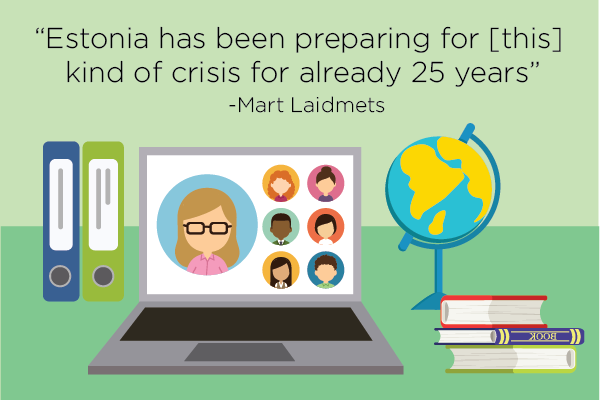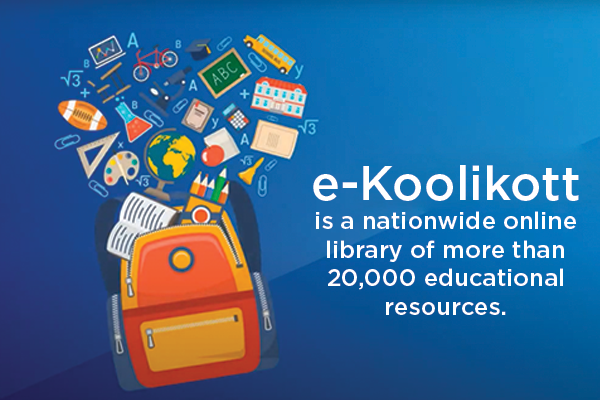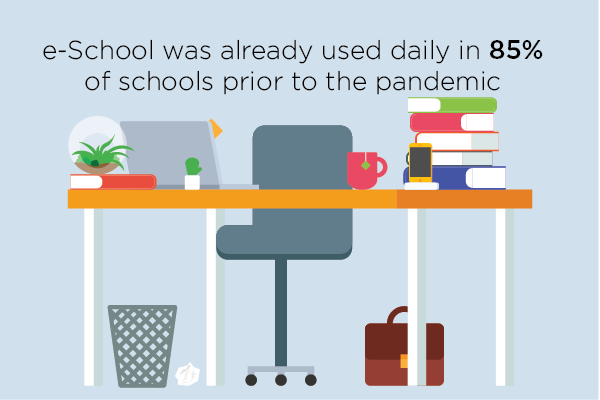Like nearly 190 countries around the world, Estonia has closed schools nationwide in response to concerns about the spread of coronavirus. But unlike many countries, Estonia built on years of preparation during its mid-March transition to distance learning; as Mart Laidmets, the secretary general of Estonia’s Ministry of Education and Research, recently explained: “Estonia has been preparing for [this] kind of crisis for already 25 years.” Estonia’s approach has included not only long-term investments in technology infrastructure and digital resources, but also strategic efforts to promote quality in online educational experiences, including aligning digital resources to a strong national curriculum and preparing and supporting teachers to use them effectively to teach the curriculum in an online environment.

Since gaining independence in the early 1990s, Estonia has transformed itself into a digital society, which has resulted in a high level of public trust in technology solutions. While Estonia is perhaps best known for its advances in e-governance, which allow Estonians to access nearly all government services online, this commitment to technology applies to education as well. Estonia’s efforts to leverage technology for teaching and learning began in the 1990s with an ambitious program to build up schools’ technology infrastructure, including providing internet access to all schools nationwide. By the early 2000s, Estonia had already met this goal and moved on to developing digital resources for online teaching and learning. Throughout these early years and in the years that followed, as new technologies and digital resources were introduced, Estonia maintained a parallel focus on building digital literacy skills among educators and students. For example, school-based educational technologists—experienced teachers who complete an additional master’s degree to become technology integration specialists—have supported teachers in Estonian schools since 2005. Their focus is on how digital resources can best be used to enhance the curriculum.
Two government-supported foundations—the Innove Foundation, founded in 2003 to provide implementation support for the Ministry of Education and Research, and the Information Technology Foundation for Education (HITSA), founded in 2013 to promote digital skills development in education—have played key roles in centrally organizing and curating Estonia’s collection of digital resources. These resources, which today form the backbone of Estonia’s jurisdiction-level support for distance learning, are described below.
 The primary source of digital resources in Estonia is e-Koolikott (“e-Schoolbag”), a nationwide online library of more than 20,000 educational resources. E-Schoolbag was developed in 2016 by the Ministry of Education and Research and is currently run by the Innove Foundation and HITSA. Teachers, subject specialists, universities, and private publishers can all post resources to e-Schoolbag, and groups of subject-area experts are responsible for reviewing the resources for quality. Teachers can then use and adapt these resources for their lessons, including organizing and saving related resources into personal “learning kits.” Parents and guardians also have access to e-Schoolbag to support children’s learning at home, as was the case before school closures.
The primary source of digital resources in Estonia is e-Koolikott (“e-Schoolbag”), a nationwide online library of more than 20,000 educational resources. E-Schoolbag was developed in 2016 by the Ministry of Education and Research and is currently run by the Innove Foundation and HITSA. Teachers, subject specialists, universities, and private publishers can all post resources to e-Schoolbag, and groups of subject-area experts are responsible for reviewing the resources for quality. Teachers can then use and adapt these resources for their lessons, including organizing and saving related resources into personal “learning kits.” Parents and guardians also have access to e-Schoolbag to support children’s learning at home, as was the case before school closures.
The e-Schoolbag resources are organized to support teaching and learning of Estonia’s national curriculum. They are searchable by curriculum subject and grade level as well as by other required elements of the national curriculum, such as Key Competency (e.g., Communication) or Cross-Curricular Theme (e.g., Environment and Sustainable Development). As part of Estonia’s goal to develop digital resources covering the full general education curriculum by the end of 2020, Estonian law has required all new hard-copy textbooks and workbooks to be made available in digital form since 2015. Beginning in 2016, textbook publishers have provided links to these digital resources via e-Schoolbag. While use of some publishers’ digital resources requires a fee, others are available free of charge. One major provider of digital textbooks and workbooks, for example, offers free access for compulsory school students and teachers.
In addition to e-Schoolbag, the Innove Foundation and HITSA provide lists of online learning resources by subject, purpose, or grade span, including tools developed by Estonia’s robust educational technology sector. Some of these lists were available prior to school closures, while others respond to specific needs raised by distance learning, such as the need to assess and provide feedback to students entirely online. In general, the goal of these lists is to compile existing digital resources that are familiar to educators and students, rather than introducing or developing new tools and resources in real time. As Heli Aru-Chabilan, the chair of HITSA, has explained: “Our strategy [during the transition to distance learning] was that no school or teacher would be forced to learn how to use completely new technologies in the state of emergency. Instead, we supported the use of the platforms which the schools already had in place.” To support schools and teachers to use these existing technologies in innovative ways, Estonia’s educational technologists have contributed to the creation of resources and guidance at the national level and provided targeted support, such as advice and instructional videos, at the school level.
 To help manage the administrative aspects of distance learning, most schools in Estonia use an online platform called e-Kool (“e-School”). Developed through a public-private partnership in 2002, e-School was already used daily in 85 percent of schools prior to the pandemic. E-School allows teachers to record student attendance and grades, post and collect student assignments, and send messages to students’ parents and guardians within an online platform that is also accessible by students and their families. While other educational technology applications provide a similar range of features, e-School’s widespread use in Estonia was key to a smooth transition to distance learning. E-School has seen increased use of features that are particularly useful for distance learning, such as home-school messaging and file sharing.
To help manage the administrative aspects of distance learning, most schools in Estonia use an online platform called e-Kool (“e-School”). Developed through a public-private partnership in 2002, e-School was already used daily in 85 percent of schools prior to the pandemic. E-School allows teachers to record student attendance and grades, post and collect student assignments, and send messages to students’ parents and guardians within an online platform that is also accessible by students and their families. While other educational technology applications provide a similar range of features, e-School’s widespread use in Estonia was key to a smooth transition to distance learning. E-School has seen increased use of features that are particularly useful for distance learning, such as home-school messaging and file sharing.
As the Estonian government makes tentative plans to allow small groups of students to return to schools in mid-May, it is not yet clear what impact the period of nationwide distance learning will have on teaching and learning long-term. But if the past two decades of strategic integration of technology into the education sector are any indication, Estonia will take this latest experience as a learning opportunity as it continues to lead in this area.




